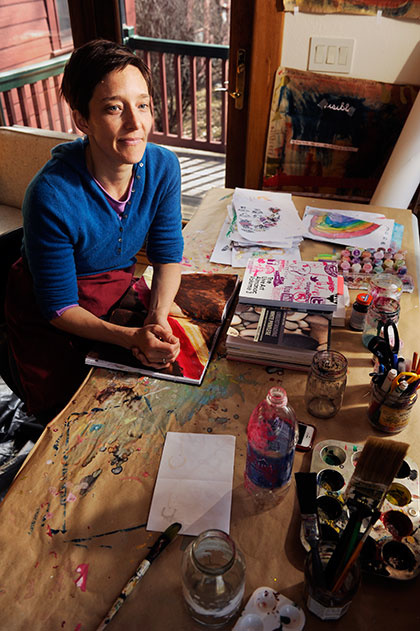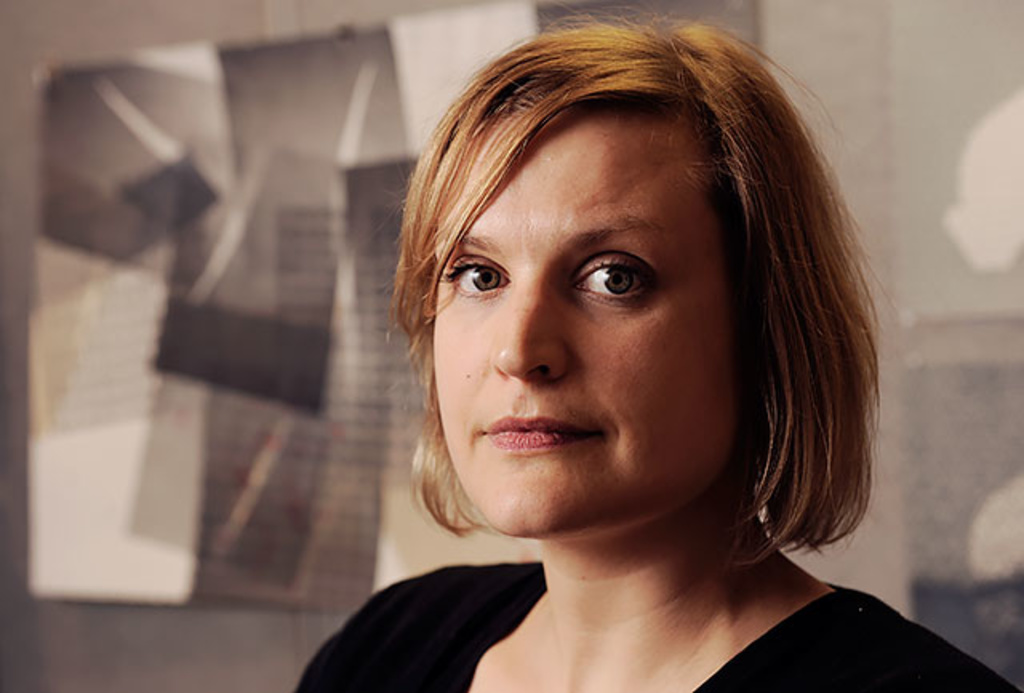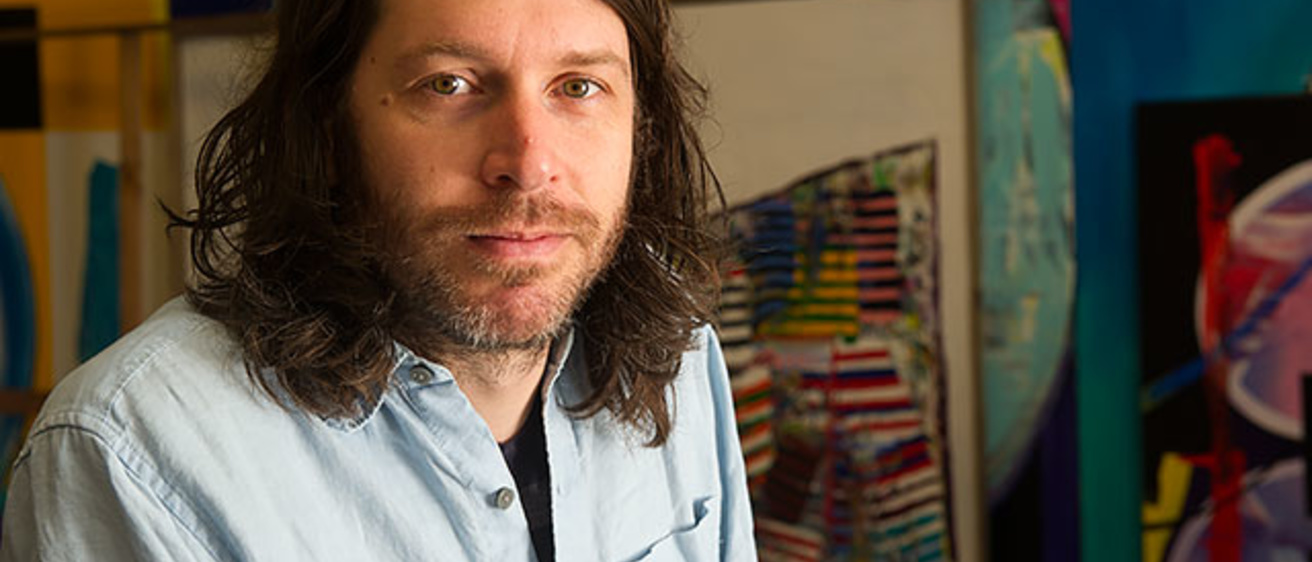Three unique artists, one common sentiment: the Grant Wood Fellowships at the University of Iowa have provided a wonderful experience.
“Being part of the Grant Wood Art Colony has been extraordinary. I am thankful to all those who make this program possible and to the students and colleagues that informed my stay here,” says Kristina Paabus, this year’s Grant Wood Fellow in Printmaking. “My time at the University of Iowa has been pivotal, and I will carry the experience and friendships with me in all of my future adventures.”
Eric Sall and Esther Baker-Tarpaga, Grant Wood Fellows in Painting and Interdisciplinary Performance, respectively, echo that sentiment. The Fellows, selected through a national competition, have taken up residence at the Grant Wood Art Colony (centered at 1131 E. Burlington St.) and have taught courses here at the university. The remainder of the time is left for the artist’s own work and research. A teaching salary, benefits, and studio are provided.
In the weeks leading up to the Grant Wood Symposium, which will be held April 25-26 and hosted by the UI School of Art and Art History, the Grant Wood Fellows discussed their work, the benefits of the fellowship, the direction they will take post-fellowship, and if their Iowa City experiences matched up with their expectations.
How would you best describe your work, the style of your work?
Baker-Tarpaga: I am a choreographer, performance artist, dancer, and interdisciplinary artist. As a frequent border-crosser between North America and Africa, I have the privilege of meeting many people who are working as artists and advocates to shift perceptions of Africa. These experiences inform my work to reflect the potential for movement and expansion when working with limitations from internal or external conditions. My art consistently revisits the themes of struggle and resistance as social justice issues. I call my performance process “ethnochoreographic” because I draw from the embodied histories of each performer. In the past several years my recent work as a performance artist with La Pocha Nostra/Guillermo Gomez-Pena has opened up an artistic practice where my work is grounded in the rich intersections between text, visual art, sound, and body.
Paabus: In my work I examine the systems of logic and order that we use to enforce our perceptions of structure. Through a multidisciplinary approach, I create hybrid spatial conversations that elaborate on the constructions that allow us to interact with, and gain control over, our surroundings. These specific systems, such as language, architecture, beliefs, and organizational tools, serve as guides to our relationship to the world around us. Our interactions and conversations with these systems often inhabit polarities of fact and fiction. These spaces of actuality, memory, imagination, and paradox describe the nuances of our experiences.
Sall: The brunt of my work is painting, typically oil on canvas. Stylistically you could say they are abstract, though my paintings often allude to the presence of something: a familiar object, a reminiscent form, a shape. They tend to be evocative without being too specific. I use paint liberally and juxtapose thin passages with thick globs, matte surfaces with shiny ones, and bright colors with lots of black, white, and gray.

How did the Grant Wood Fellowship come across your radar?
Paabus: The previous Grant Wood Fellow in Printmaking, Jeremy Lundquist, was a colleague and friend of mine from the School of the Art Institute of Chicago. I had heard wonderful things about this unique program and Jeremy’s experience, so I jumped at the chance when I saw the call come up on the academic posting sites. Long aware of the history and well-deserved reputation of printmaking at the UI’s School of Art and Art History, I was very interested in spending time here.
Sall: My wife, Rachel, is an artist as well, and she had an exhibition at Coe College back in 2011. We came down to Iowa City to visit Rachel's cousin who lives here, and heard about the fellowship through him. We were living in Brooklyn, N.Y., at the time, and the timing just wasn't right to apply. I was reminded of the fellowship again last spring through a friend who went to graduate school here in Iowa City, and decided that it was a good time to apply.
What have been the greatest benefits of the fellowship?
Sall: The amount of time I've had to work in my studio, the time I've had to spend with my family, and the opportunity to work at the university with such talented students and faculty. The fellowship provides a certain level of freedom in a way, to have a more open lifestyle, by not worrying about rent for a year, or having to work a 40-hour-a-week job. Not worrying about those things allows me to focus on my painting and teaching career and my family.
We moved here from Brooklyn, where we lived in a tiny apartment. My wife and I shared a modest studio. I was working a full-time job to afford the crazy rent and support our family. Living in Iowa City has been a complete lifestyle change for the better thanks to the Fellowship.
Baker-Tarpaga: Time and space to work. Contact with the university students. The interdisciplinary nature of my work and the support of the fellowship coming from the areas of visual arts and dance. A paid fellowship for a year and lodging really permitted me to dive into my research and have the breath and breadth. In addition, being affiliated with the university permitted me access to different resources and I connected to different faculty, community members, and students in Iowa City.
Paabus: It has offered me the necessary time, space, and resources to single-mindedly focus on my creative and academic practices. This dedicated time for research, development, experimentation, making, and reflection has been crucial at this point in my career. Having my studio on campus—right next to the printmaking facilities, down the hall from the wood shop, and in the midst of daily activity—has been a wonderful asset to my work. Through both this integration and the teaching of classes, I have been able to work closely with students, faculty, and staff. These dedicated and enthusiastic individuals have been invaluable to my experience here through camaraderie, discussion, and the constant exchange of ideas.
The UI’s emphasis on research, and commitment to the arts, provides an academic setting that recognizes the importance of community, facilities, and programming. Living in the Grant Wood Art Colony has allowed me to get to know the other fellows, proximity to all the activities Iowa City has to offer, and a chance to see trees and rabbits on a daily basis.
What did you expect coming to Iowa? Encounter any pleasant surprises?
Baker-Tarpaga: My father grew up in Vinton. His family were dairy farmers. I only visited the farm during the summer for short visits, after my grandparents passed away, but there is a connection to the land and ancestors working the land here. I was surprised at the strong artistic corridor, the liberal progressive city, and radical politics in some ways. People are so friendly and this has been very nice and pleasant for my family and me.
Sall: I grew up in South Dakota, so I had some idea of what to expect out of the region. The vast open spaces, the friendly people. The hot summers, the super-cold winters. I was surprised by just how beautiful this part of Iowa is, though. I love driving around the area looking at farms and finding scenic areas to check out. My studio is at the UI Research Park; it is pretty remote out there. I’ve seen deer and turkeys out my windows while I was working—a far cry from what was out my studio window in Brooklyn! It’s been cool to see all the bald eagles around here this winter. I am also very happy with the local food options; the co-op is my favorite store.
Paabus: Beyond a phenomenal research university, I really had no idea what to expect when coming to Iowa—it was definitely a step into the unknown. Since my arrival I have been constantly surprised by the caliber and quality of life in Iowa City, from the active arts community and campus events, to access to natural settings. Seeing the landscapes that influenced Grant Wood’s paintings provided me with a new understanding of his work and the idea of Regionalism; it furthered my deep appreciation for the Midwest.

Have you been taking new angles with your work during your fellowship?
Baker-Tarpaga: My current research is on race, sexuality, and motherhood as performance impetus for the body. Specifically I have been obsessed with inscribing, writing, costuming, and improvising my dancing body as well as the bodies of others. As I inscribe and write on my body or ask others to do so, I am interested in what is visible and what is invisible. These collaborations bring in heavy use of props, text, performance interactions with audiences, site, activism, and border politics, among many other things. It is a home for my questions around what is representation, what is fantasy, what is autobiography, and how do my performance glitches sit next to other personas simultaneously.
As part of the residency I have been reflecting on past performance projects as well as taking time to research writings and videos on the subject of White Privilege in relation to oppression and structural racism. As I read texts and pull together ideas, I process these reflections through writing poetry and painting. This interdisciplinary practice in a visual and poetic medium allows time and space to figure out ideas through material traces. As a choreographer who works very quickly with the bodies, I translate my improvisations to the paper and pen. This space and time to process and perform through material traces allows a necessary breath of reflection before returning to the choreographed body. I have assembled 14 small paintings from this process into a book, which will be on display at the University of Iowa in April.
I also have been collaborating with a local photographer, to create a performance art and photography project based on several of Grant Wood’s paintings, in particular his portrait work. The photos will be on display at the Grant Wood Symposium, and with the performers, will create performative tableau vivantes. Using the iconic portrait tradition I am interested in framing a queer, racially diverse utopia. Local community members are involved in this project.
Paabus: My current body of work continues to explore shared and individual codes, but now through the lens of game theory. Games inherently inhabit a sense of structure, strategy, duality, competition, causality, success, and failure. It is through this discussion that I am able to research behavioral relations within both liminal and obvious spaces. Avoiding the implications of a specific game, I instead employ the language of games to study rules, planning, cause, and effect. The prints consider systems, strategy, patterns, and the processes of decision-making, while the sculptures act as characters, consequences, and situations. I employ printmaking in all of this work for its unique ability for repetition, reinterpretation, and the layering of information.
What lies ahead, post-fellowship?
Paabus: I am looking forward to continuing my research, moving to Ohio, and beginning my new role as the assistant professor of reproducible media at Oberlin College.
Sall: We are moving to Roswell, N.M., in August to attend the Roswell Artist-in-Residence Program, which is a yearlong residency out in the desert Southwest. Rachel and I were residents there back in 2002-03; we got married there. We are returning all these years later with our two young children, and we are excited to see how different it will be this time.
Baker-Tarpaga: More performance, art making, collaboration, teaching, and cross-cultural exchange. At this exact time, I am not sure where we will be geographically. This summer we are taking University of Iowa students to Burkina Faso for our annual Dance, Drum, and Intercultural collaboration annual abroad program.
